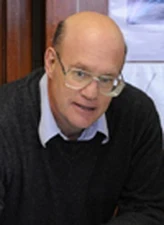Seth Stein

The 2010 Stephan Mueller Medal is awarded to Seth Stein in recognition of his outstanding contributions to the study of the kinematics and dynamics of plate boundaries and plate interiors based on innovative applications of seismology and space-geodesy, and his role in establishing the first Plate Boundary Observatory.
The approach of Seth Stein to science is illustrated by pioneering studies of the great December 2004 Sumatra earthquake. Stein and E. Okal were the first to recognize that the earthquake was much larger than initially reported, a result that surprised the seismological community but was quickly confirmed by many investigators using multiple techniques. Using an elegant analysis method for long period normal mode data that he had developed in his thesis, he showed that the earthquake involved slip along a rupture much larger than previously inferred, which explained why the resulting tsunami was so destructive. Integrating this result with marine magnetic and GPS data to derive relative motion of the Indian plate beneath the Burma micro-plate showed that such earthquakes should recur approximately 500 years apart, a result confirmed later by palaeoseismology. The study also noted that the danger of a tsunami resulting from a great earthquake on segments to the south remained, which occurred the week the paper appeared, three months after the December earthquake. His subsequent study invalidated the widely accepted model that such great earthquakes could occur only where young lithosphere subducts quickly, and showed that the apparent correlation likely resulted from that fact that giant (e.g., magnitude 9) earthquakes rupturing multiple trench segments are much rarer than those rupturing single segments.
He has conducted similar multidisciplinary studies, including co-organizing and developing the NUVEL-1 model of plate motions. The results have redrawn the world plate map in several areas and become the standard for comparison with space geodetic data. He has been a leader in using GPS data for comparison with other data to explore how motions over millions of years compare with those over a few years.
His studies have also explored other aspects of plate dynamics. He has helped to identify the surprising worldwide occurrence of large earthquakes along “passive” continental margins, explored their origin and led the recognition of the hazard they pose. His studies of the thermal and mechanical evolution of oceanic lithosphere identified the systematic variation in earthquake depth that reflects and constrains plate cooling. His models of the thermal structure and evolution resolved systematic misfits of earlier models and gave a new insight into the magnitude and age distribution of water flux through the oceanic lithosphere.
In recent years he has investigated earthquakes within continents. His studies of the central US find a surprising lack of deformation, leading a new paradigm of intra-continental earthquakes as episodic and migrating on a network of interacting faults. They suggest that many recent, small mid-continental earthquakes are aftershocks of large earthquakes that occurred hundreds of years ago, consistent with a model predicting that the length of aftershock sequences varies inversely with the rate at which faults are loaded. These results show how views of earthquake recurrence in space and time are limited by the short history of instrumental seismology compared to the long and variable recurrence time of large earthquakes and have major implications for earthquake hazard.
He is a leader in the geophysical community. As director of UNAVCO, the international organization of geoscience research institutions working with GPS, he helped organise the US Earthscope programme. He has served in community roles including editing JGR, writing a widely used seismology textbook, and working with news media in the US and Europe to improve public understanding of seismology, earth science and related policy issues.
Stein’s long-standing ties to European colleagues include numerous joint studies. He has served on European thesis committees and mentored some of Europe’s finest young scientists in the Netherlands, Germany, Portugal and Hungary. He has fostered trans-Atlantic cooperation in space geodesy and opened opportunities including appointing the first European associate editors for JGR. He served on the governing board of the WEGENER European space geodesy consortium and currently is a member of the External Advisory Board of the Netherlands Research Centre for Integrated Solid Earth Science, and review panels for the ESF TopoEurope and DFG SAMPLE South Atlantic research programmes.
